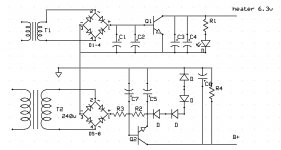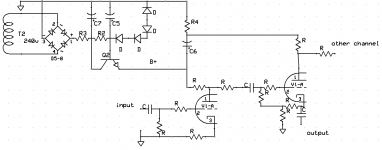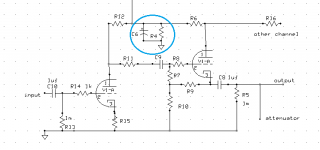Ok, finally had time to look again at the board, this is what I see as the psu section of the board. I also found 2 old guitar preamp tubes, 12ax7-a from mesa boogie.
I don't know if I've got the transistors right or not, and I don't know what they could be...
Got suggestions for the component values?
I don't know if I've got the transistors right or not, and I don't know what they could be...
Got suggestions for the component values?
Attachments
Perhaps if I try to be more specific....
After doing lots and lots of searching I found out that this seems to be a 2 stage preamp, having a gain stage with a cathode follower. Some calculators can give me values for the parts I need but not when I have the two combined....
Question 1: what is the use of what I circled in blue?
Question 2: most designs do not use a resistor in r6, why this one?
Question 3: how can I calculate for both stages? what gain should I aim for?
And finally, since this will more than likely be used with 12ax7 tubes, with a b+ between 200 and 220 (with the parts I have handy), What values should I aim for for the remaining parts?
Thanks in advance to anyone who can help,
John
After doing lots and lots of searching I found out that this seems to be a 2 stage preamp, having a gain stage with a cathode follower. Some calculators can give me values for the parts I need but not when I have the two combined....
Question 1: what is the use of what I circled in blue?
Question 2: most designs do not use a resistor in r6, why this one?
Question 3: how can I calculate for both stages? what gain should I aim for?
And finally, since this will more than likely be used with 12ax7 tubes, with a b+ between 200 and 220 (with the parts I have handy), What values should I aim for for the remaining parts?
Thanks in advance to anyone who can help,
John
Attachments
1. Power supply decoupling. This is to reduce the unintentional feedback between stages through the power supply.
2. Lots of designs do. It's very common practice.
3. This will depend on what you're putting in the input and what you want to get out of the output. This may seem flippant, but in all seriousness, start with a rigorous definition of what you're trying to accomplish.
2. Lots of designs do. It's very common practice.
3. This will depend on what you're putting in the input and what you want to get out of the output. This may seem flippant, but in all seriousness, start with a rigorous definition of what you're trying to accomplish.
The ultimate goal is to have a tube preamp to put before my quad 405, which is a solide state amp that I modified in the past few weeks (and it rocks). I understand that a tube preamp and a solid state amp is a good combo, which is why I want that preamp (I had the boards in a pile of crap, and I found old tubes last week in an box with my remaining guitar stuff).
Sources are : pc, phono(there is a tube phono stage as well), and cd.
So, line and phono input, amp output.
Is there a way for me to calculate all the values with my little knowledge in electronics, or should I just cry for help? I found a few online calculators, but there is always something that's not exactly like my design, and since I don't know how to find out the values....
One again, help is more than appreciated
Sources are : pc, phono(there is a tube phono stage as well), and cd.
So, line and phono input, amp output.
Is there a way for me to calculate all the values with my little knowledge in electronics, or should I just cry for help? I found a few online calculators, but there is always something that's not exactly like my design, and since I don't know how to find out the values....
One again, help is more than appreciated
OK, let's try to translate that into design requirements. Your power amp requires 0.5V for full power out. It presents a load of 20k in parallel with 220pF. Your connecting cables may add another 100-200pF or even a bit more, so the preamp should be happy driving 0.5VRMS into 20k and 400-500pF.
PC and CD are likely to be 2-3V sources at low impedance. So you don't need much gain, if any, in your lineamp. A unity gain buffer is perfect for your setup as a lineamp. If your wires are short, you don't even need that, a simple potentiometer and switch will do.
Phono stage gain can be similarly outlined, but you have to start with the cartridge, and specify its output, its optimal load, and its source impedance (should be on manufacturers spec sheet) to determine what the design goals for that stage need to be.
PC and CD are likely to be 2-3V sources at low impedance. So you don't need much gain, if any, in your lineamp. A unity gain buffer is perfect for your setup as a lineamp. If your wires are short, you don't even need that, a simple potentiometer and switch will do.
Phono stage gain can be similarly outlined, but you have to start with the cartridge, and specify its output, its optimal load, and its source impedance (should be on manufacturers spec sheet) to determine what the design goals for that stage need to be.
I see, how then would I go with this schematic for a unity gain buffer? btw I will have an attenuator (stepped), added as well. (wire are not short, especially from the pc)
I noticed that having a plate and a grid resistor of the same value on the first stage seems to give close to zero gain, but then again, do all values have the same effect? How do I go from there to the other stage?
thanks in advance
I noticed that having a plate and a grid resistor of the same value on the first stage seems to give close to zero gain, but then again, do all values have the same effect? How do I go from there to the other stage?
thanks in advance
OK, now that you know what you want your preamp to do (assuming you define the phono stage required gain), what you really need next is a complete tutorial on designing gain blocks and putting them together into a working circuit. You can do no better than getting yourself a copy of Morgan Jones's "Valve Amplifiers," pouring yourself a nice glass of wine (or in the author's honor, some 15 year old single malt), and working through the book. Well written, clear, and practical.
Get down the basics, and then you've got a great resource here in the forum for refining your ideas and helping you over the rough patches.
Get down the basics, and then you've got a great resource here in the forum for refining your ideas and helping you over the rough patches.
- Status
- This old topic is closed. If you want to reopen this topic, contact a moderator using the "Report Post" button.
- Home
- Amplifiers
- Tubes / Valves
- Got unknown tube preamp board, need help!


